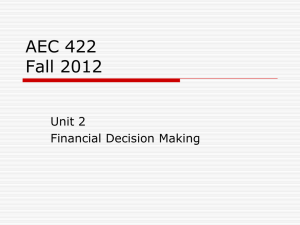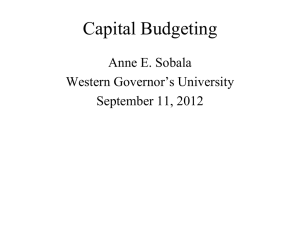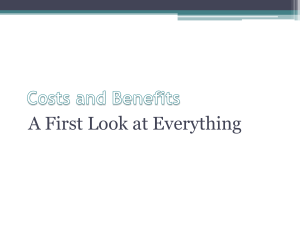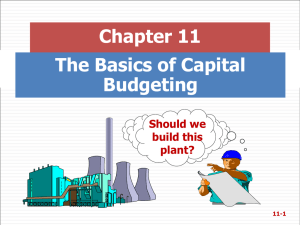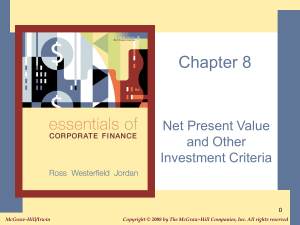Project Analysis/Capital Budgeting Review
advertisement
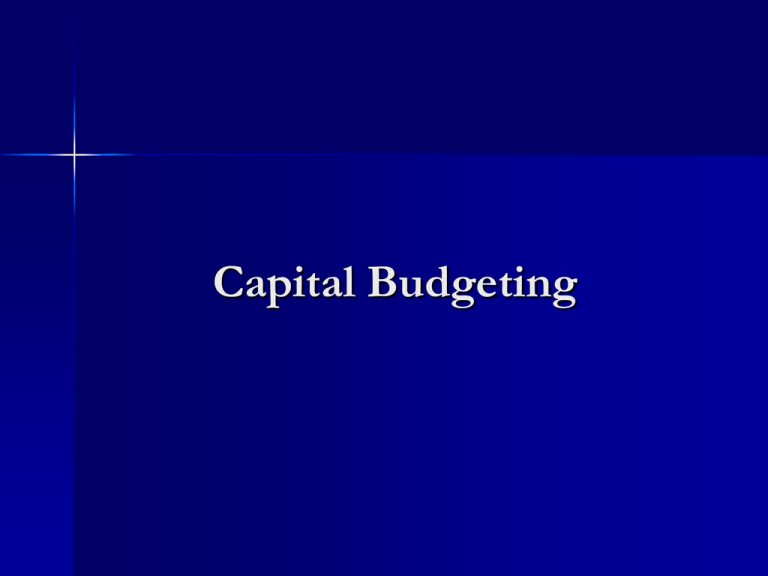
Capital Budgeting Investment Decision Cash Investment opportunity (real asset) Firm Invest Shareholder Pay dividend to shareholders Investment opportunities (financial assets) Shareholders invest for themselves Investment return must exceed the return on investing in a financial asset of equivalent risk to accept the project Net Present Value Project Market Value - Project Cost 1. Estimate all cash flows, positive and negative 2. Estimate project’s required return 3. Find the present value of the cash flows Discount all future cash flows n t 0 CFt NPV t 1 k NPV > 0 : Accept NPV < 0 : Reject NPV: Value to Equity Holders Investors: – You $20,000 & Brother $30,000 Buy a thoroughbred horse $50,000 Present value of sale $60,000 – NPV = Gain for equity holders – Brother’s share = – Your share = Negative NPV Air Quality Control Act requires a firm to install 3 cleaner ventilation systems Cash Flows – Cost: $350,000/unit – Value: Avoid $100,000/unit in fines annually over the 5 year life of the units. At r =14%, NPV = -$20,075 Project Analysis Alternative analysis of cash flow estimates – Payback – Internal Rate of Return Supplements to NPV analysis – – – – Sensitivity Analysis Break-even Analysis Monte Carlo Simulation Decision Trees Payback Payback Period – Number of years it takes before the cumulative forecasted cash flow equals the initial outlay Payback Rule – Only accept projects that “payback” in the desired time frame Fixed & Variable Costs Total Costs = Fixed + Variable Costs – Total variable costs = quantity * cost per unit – Fixed costs are constant over some time period Ex: Your firm pays $3000 per month in fixed costs. You also pay $15 per unit to produce your product. – What is your total cost if you produce 1000 units? – What if you produce 5000 units? Example New experimental laser medical treatment – – – – Purchase of new laser costs $250,000 Installation will cost $20,000 Hourly labor costs are $830 (doctor, nurse, tech) Charge $3,000 vs. $1,500 for traditional treatment Break-even Calculation – Fixed costs = – Variable costs = – Break-even = Internal Rate of Return IRR is the discount rate that forces PV of the inflows equal to the initial outflow (cost). NPV: Enter r, solve for NPV. n CFt NPV t t 0 1 r IRR: Enter NPV=0, solve for IRR. n CFt 0 t t 0 1 IRR IRR Rationale IRR > Opportunity Cost of Capital – Project’s rate of return is greater than its cost – Extra return is left after repaying financing to boost stockholders’ returns IRR > r : Accept IRR < r : Reject Mutually Exclusive Projects NPV: choose the project with the higher NPV IRR: choose the project with the higher IRR Period Project A Project B 0 1 -500 325 -400 325 2 325 200 IRR 19.43% 22.17% NPV 64.05 60.74 Req. return for both projects is 10%. Which project should you accept and why? Relevant Cash Flows Incremental cash flows – Any and all changes in cash flows due to accepting a project – “Will this cash flow occur ONLY if we accept the project?” Stand-alone principle – Analyze each project in isolation from the firm Common Cash Flows Sunk costs – Costs that have accrued in the past Opportunity costs – Costs of lost options Side effects – Positive: benefits to other projects – Negative: costs to other projects Taxes Incremental Cash Flows Luxury Car currently sells – 30,000 cars at $45,000 and 12,000 SUVs at $85,000 Introduces a motorcycle Expects to sell 21,000 at $12,000 = $252 mil Changes brand – SUVs decrease: -1,300 * $85,000 = - $110.5 mil – Cars increase: 5,000 * $45,000 = $225 mil – Net sales Evaluating NPV Estimates NPV estimates are just that – estimates – NPV ≠ Actual Profitability Forecasting risk – More sensitive NPV estimates, the greater the forecasting risk – Sources of value Sensitivity Analysis NPV impact when vary one variable Vary inputs separately – Determines project’s realizations with better/worse outcomes of key variables Shows sensitivity to forecasting errors Scenario Unit Sales Cash Flow NPV IRR Baseline 6000 59,800 15,567 15.1% Worst case 5500 53,200 -8,226 10.3% Best case 6500 66,400 39,357 19.7% Sensitivity Analysis Must identify key variables – Determines where additional information is needed – Exposes confused forecasts Results are often ambiguous – Difficult to evaluate true probability distribution of outcomes How likely is each state of the world? – Interactions? Strong demand higher market size / price Scenario Analysis Alternative to sensitivity analysis Examines outcome given certain events – Ex: Increased oil prices and car market Consider at least – Best case: high revenues, low costs – Worst case: low revenues, high costs – Measure of the range of possible outcomes Simulation Analysis Managers can consider many possible combinations Generates a probability distribution and estimates probability of positive NPV. Discounting & Risk High Risk Project with Cost of $125,000 – If successful, firm will build a $1 million plant which would generate $250,000/yr after taxes – Otherwise, project will be dropped – 50% probability of success Expected cash flows: C0 = -125 C1 = .5(-1,000) + .5(0) = -500 Ct for t=2,3,…=.5(250) + .5(0) = 125 Discounting & Risk High risk so management uses a project discount rate of 25%. NPV – All: -125 - 500/1.25 +(125/.25)/1.252 =negative Problematic approach – If the test is a failure, then there is no risk at all! – If successful, there may be normal risk afterwards. Decision Tree Analysis Low risk if pilot is successful – Discount rate of 10% Success 50% NPV= -1000 + (250/.1)/1.1 = 1,272 Pilot production and test marketing 50% Failure NPV = 0





